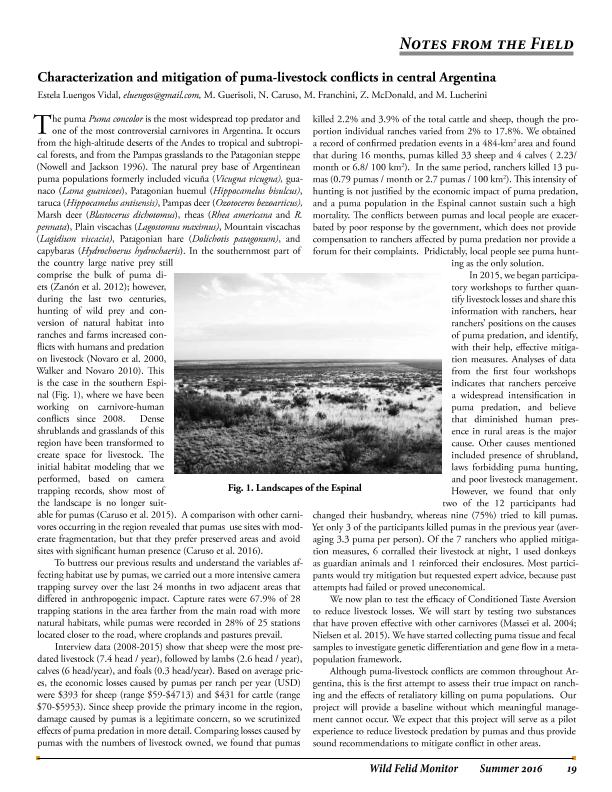Artículo
Characterization and mitigation of puma-livestock conflicts in central Argentina
Luengos Vidal, Estela Maris ; Guerisoli, Maria de Las Mercedes
; Guerisoli, Maria de Las Mercedes ; Caruso, Nicolás
; Caruso, Nicolás ; Franchini, Marcello; McDonald, Zara; Lucherini, Mauro
; Franchini, Marcello; McDonald, Zara; Lucherini, Mauro
 ; Guerisoli, Maria de Las Mercedes
; Guerisoli, Maria de Las Mercedes ; Caruso, Nicolás
; Caruso, Nicolás ; Franchini, Marcello; McDonald, Zara; Lucherini, Mauro
; Franchini, Marcello; McDonald, Zara; Lucherini, Mauro
Fecha de publicación:
07/2016
Editorial:
Wild Felid Research and Management Association
Revista:
Wild Felid Monitor
ISSN:
2167-3861
Idioma:
Inglés
Tipo de recurso:
Artículo publicado
Clasificación temática:
Resumen
The puma Puma concolor is the most widespread top predator and one of the most controversial carnivores in Argentina. It occurs from the high-altitude deserts of the Andes to tropical and subtropical forests, and from the Pampas grasslands to the Patagonian steppe (Nowell and Jackson 1996). The natural prey base of Argentinean puma populations formerly included vicuña (Vicugna vicugna), guanaco (Lama guanicoes), Patagonian huemul (Hippocamelus bisulcus),taruca (Hippocamelus antisensis), Pampas deer (Ozotoceros bezoarticus), Marsh deer (Blastocerus dichotomus), rheas (Rhea americana and R. pennata), Plain viscachas (Lagostomus maximus), Mountain viscachas (Lagidium viscacia), Patagonian hare (Dolichotis patagonum), and capybaras (Hydrochoerus hydrochaeris). In the southernmost part of the country large native prey still comprise the bulk of puma diets (Zanón et al. 2012); however, during the last two centuries, hunting of wild prey and conversion of natural habitat into ranches and farms increased conflicts with humans and predation on livestock (Novaro et al. 2000, Walker and Novaro 2010).
Palabras clave:
Puma
,
Conflict
,
Livestock
Archivos asociados
Licencia
Identificadores
Colecciones
Articulos(CCT - BAHIA BLANCA)
Articulos de CTRO.CIENTIFICO TECNOL.CONICET - BAHIA BLANCA
Articulos de CTRO.CIENTIFICO TECNOL.CONICET - BAHIA BLANCA
Citación
Luengos Vidal, Estela Maris; Guerisoli, Maria de Las Mercedes; Caruso, Nicolás; Franchini, Marcello; McDonald, Zara; et al.; Characterization and mitigation of puma-livestock conflicts in central Argentina; Wild Felid Research and Management Association; Wild Felid Monitor; 9; 2; 7-2016; 19-19
Compartir



